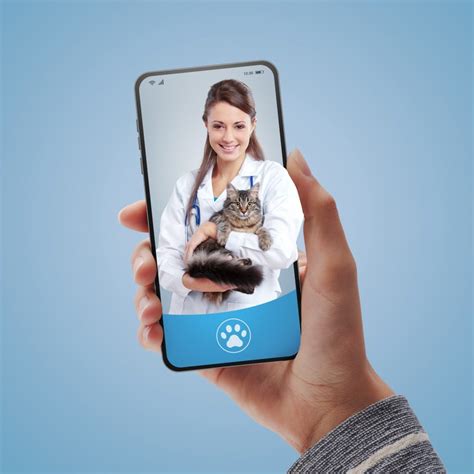Introduction
Veterinary telehealth, the delivery of veterinary care via telecommunication technology, has emerged as a powerful tool to enhance accessibility to veterinary services. By leveraging video conferencing, messaging, and other digital platforms, pet owners can connect with licensed veterinarians from the comfort of their homes. This advancement has the potential to revolutionize the delivery of veterinary care, particularly for those in rural or underserved areas and those facing mobility challenges.

Current Status of Vet Telehealth
According to the American Veterinary Medical Association (AVMA), over 80% of pet owners have expressed interest in using telehealth services. The market for veterinary telehealth is projected to grow exponentially over the next decade, with an estimated market value of $10.2 billion by 2025. This growth is attributed to several factors, including:
- Increasing adoption of technology: Pet owners are increasingly comfortable using technology for all aspects of their lives, including veterinary care.
- Rising pet ownership: The number of pet owners in the United States is increasing, fueled by the humanization of pets and the desire for companionship.
- Convenience: Telehealth eliminates the need for pet owners to travel to a veterinary clinic, saving them time and money.
- Access: Telehealth makes veterinary care more accessible to those living in rural or underserved areas, where veterinary clinics may be scarce.
Accessibility Benefits of Vet Telehealth
1. Geographic Barriers:
For rural communities, access to veterinary care can be limited due to the lack of nearby clinics. Telehealth bridges this gap by enabling pet owners to connect with veterinarians from anywhere with an internet connection.
2. Mobility Challenges:
Disabled pet owners or those with limited mobility face difficulties in transporting their pets to veterinary clinics. Telehealth allows them to consult veterinarians remotely, eliminating the need for physically demanding travel.
3. Emergency Situations:
After-hours emergencies can be stressful for pet owners. Telehealth provides a convenient and cost-effective way to get immediate advice from a veterinarian, even when physical clinics are closed.
4. Cost Considerations:
Telehealth consultations are typically more affordable than in-clinic appointments, making veterinary care more accessible to low-income families or those with financial constraints.
Challenges to Vet Telehealth Accessibility
1. Lack of High-Speed Internet:
Reliable internet connectivity is essential for effective telehealth consultations. However, in some rural areas, broadband internet access may be limited or unavailable.
2. Digital Literacy:
Not all pet owners are comfortable using technology or may not have access to devices that support telehealth consultations.
3. Limitations of Remote Examinations:
Physical examinations are essential for diagnosing certain conditions. Telehealth consultations may not be suitable for situations requiring hands-on examination or invasive procedures.
Overcoming Accessibility Challenges
1. Partnerships with Community Organizations:
Collaborating with local libraries, community centers, or telehealth kiosks can provide internet access and digital literacy training to those in need.
2. Mobile Telehealth Units:
Deploying mobile telehealth units in rural areas can extend veterinary care to remote communities.
3. Telehealth-Enabled Devices:
Developing affordable and accessible devices specifically designed for telehealth consultations can improve access for those with digital literacy challenges.
Innovation and the Future of Vet Telehealth
1. AI-Powered Diagnostics:
Artificial intelligence (AI) algorithms can assist veterinarians in analyzing medical images and providing preliminary diagnoses, enhancing the efficiency of remote consultations.
2. Wearable Health Devices:
Wearable devices that monitor pets’ vital signs and activity levels can provide valuable data for remote monitoring and early detection of health issues.
3. Virtual Reality (VR) Technology:
VR simulations can be used to train veterinary students and provide immersive learning experiences for pet owners, enhancing their understanding of animal health.
Conclusion
Vet telehealth has the potential to revolutionize the delivery of veterinary care, providing greater accessibility and convenience for pet owners. By addressing the current challenges and embracing innovation, we can ensure that telehealth services are accessible to all who need them, fostering a healthier and more equitable society for both pets and their owners.
Tables
Table 1: Benefits of Vet Telehealth
| Benefit | Description |
|---|---|
| Convenience | Consult veterinarians from home, saving time and money. |
| Access | Reach veterinarians in rural or underserved areas. |
| Emergency Situations | Get immediate advice from veterinarians after hours. |
| Cost Considerations | More affordable than in-clinic appointments. |
Table 2: Challenges to Vet Telehealth Accessibility
| Challenge | Description |
|---|---|
| Lack of High-Speed Internet | Reliable internet connection is essential. |
| Digital Literacy | Not all pet owners are comfortable using technology. |
| Limitations of Remote Examinations | Physical examinations are essential for diagnosing certain conditions. |
Table 3: Overcoming Accessibility Challenges
| Solution | Description |
|---|---|
| Partnerships with Community Organizations | Provide internet access and digital literacy training. |
| Mobile Telehealth Units | Extend veterinary care to remote communities. |
| Telehealth-Enabled Devices | Develop affordable devices for those with digital literacy challenges. |
Table 4: Innovation and the Future of Vet Telehealth
| Innovation | Description |
|---|---|
| AI-Powered Diagnostics | Assist veterinarians in analyzing medical images. |
| Wearable Health Devices | Provide valuable data for remote monitoring. |
| Virtual Reality (VR) Technology | Enhance training and provide immersive learning experiences. |





















